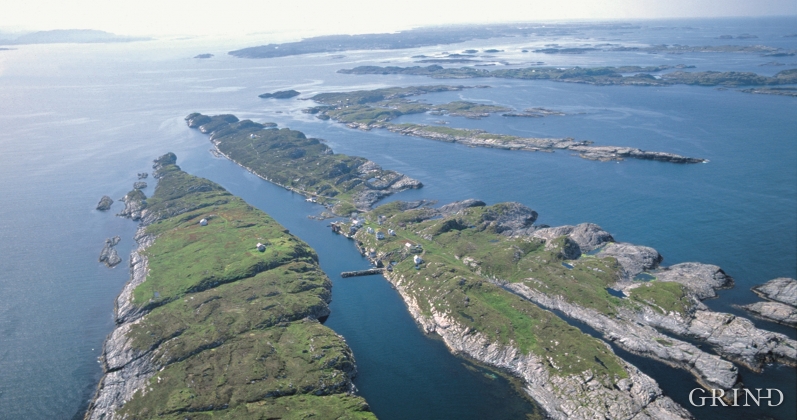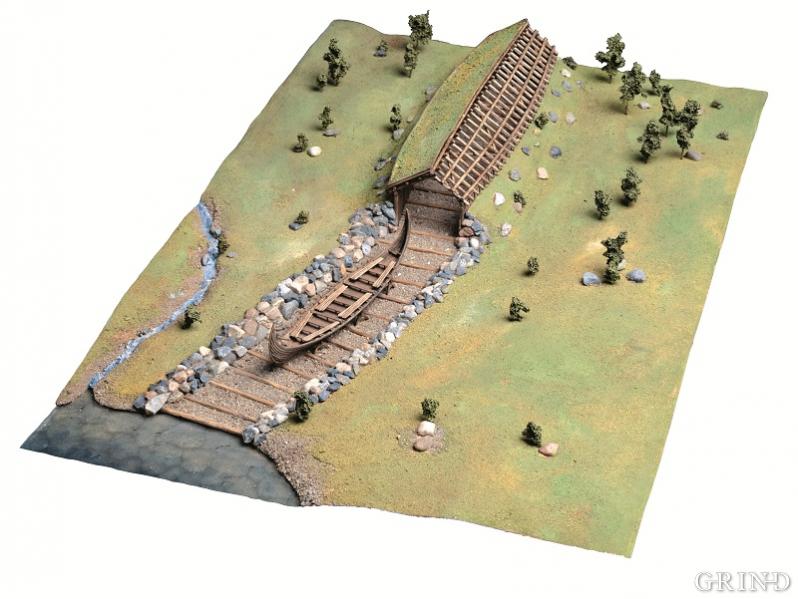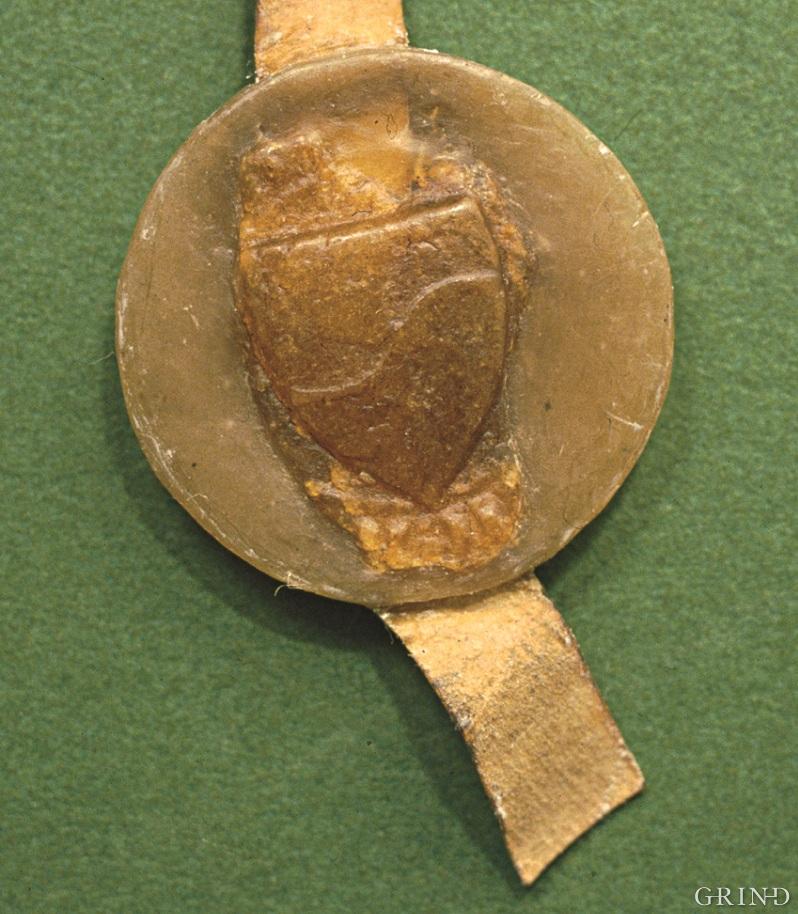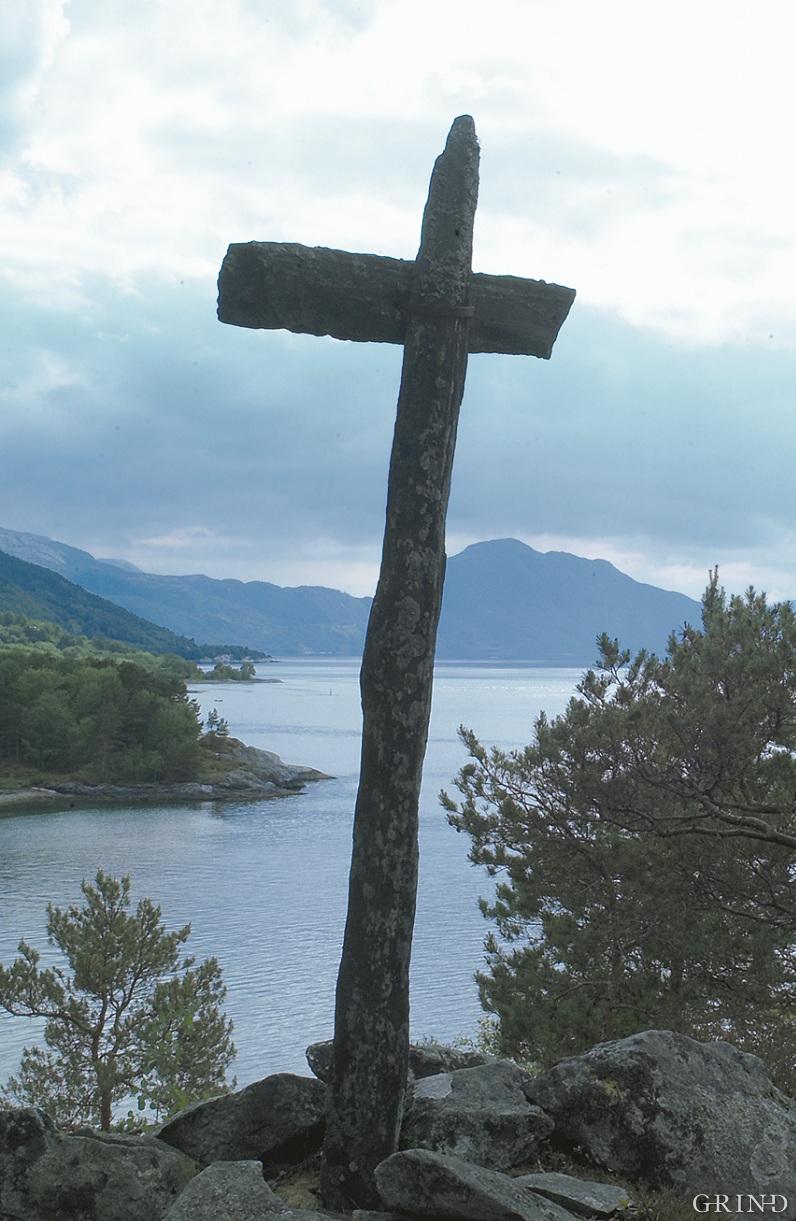Publisert: 19.05.2009 | Forfattar: Geir Atle Ersland
From Øygarden towards Hjeltefjorden (Helge Sunde).
“It was on such a chilly, silver-grey morning that the Hørde folk, the Harudes of Caesar and Tacitus, must have come running in from the sea on the wind at sunrise; at last from the Danish peninsula in the final phase of the great Folk migration, as it either crumbled under the overwhelming superior power or was pushed forward only by small folk, from the misery of many years of famine, just like the early settlers of Iceland to find better long-lasting homes; they took land for one reason or another not on the southern tip of Norway or Lister, but north of Karmøen and in the fjords of Hardanger, they sought shelter from the sea winds” This is the poet Hans E.Kinck’s lively description in his book: “Places and folk” of the emigration of the Horda people to western Norway. But what are his sources?
The landscape and people
Kinck based his account on the hypothesis that the name Hordaland is related to a Germanic tribal name. In his book on the Gallic wars from approximately the year 50 B.C., Caesar mentions a tribe in southern Germany that he termed Harudes in Latin. In the mid-500s Jordanes, who wrote the history of the Goths, wrote that among the tribes of Scandinavia there was a tribe called Arothi, and it is possible that the tribe is the same as was mentioned by Caesar 600 years previously, Within the context of Jordanes’calculations it seems that the Arothi populated what we today call Hordaland. Due to the similarity in names, the hypothesis has been presented that the Hordas wandered northwards and settled in an area that later was given the name Hordaland, the land of the Hordas. But the Hordas didn’t arrive in unoccupied territories. There were already people here who were involved in agriculture, fishing and hunting. Evidence of settlements as far back as the Stone Age is particularly abundant in this region.
Rural fortresses and chieftanship
The age of migration, the period between 400 and 600, was a period of unrest in western Norway and the many rural fortresses are characteristic cultural monuments of this age. The basis of the rural fortresses must have been organised societies who through joint efforts were prepared to defend themselves. But who was the enemy? It is possible that the fortresses are a result of conflicts between settlements. Some form of local chieftainship is highly likely and it is also likely that chieftains with ambitions of annexing neighbouring areas existed. Numerous and substantial burial finds from the age of migration indicate that there were several chieftainships within each landscape area. It may be so that the rural fortresses are an indication of where the borders between chieftainships were drawn. There is also the possibility that external threats induced the construction of the fortresses, and this may explain that it was during the age of migration that the fortresses were built and brought into use. Tribes were on the move over the entire northern European continent. This also put pressure on the settlement patterns of the outlying areas. Anxious and suspicious settlers and newcomers may have attacked one another, and the latter may have lived for a long time as wandering bands that plundered the settlements they came across.
If we let one precondition build upon the other, we end up with the possibility that it is possible that the rural fortresses were protection against the Hordas and a reminder of the time they arrived in the area. All in all, however, there is scant evidence of the migration of the Hordas and it is mere speculation. We have no other evidence that makes the migration anything else than mere guesswork.
Landscape name and county
The oldest source of the name of Hordaland is from Anglo-Saxon writings from before the 9th century, but we can safely assume that the name is even older. If we wish to establish which area is the oldest Hordaland, we nevertheless have to use medieval sources. These show that Hordaland was only used to describe the outer settlements of the county i.e. Nordhordland and Sunnhordland. An example of how the landscape names were perceived in the Middle Ages may be found in an agreement on land ownership from 1324. Here it was stated that the farm Samlanda in Jondal was in Hardanger, while that farm Landa in Kvinnherad was in Hordaland. The author cannot have perceived Hardanger as part of the Hordaland landscape and the border between Hordaland and Hardanger was between Jondal and Kvinnherad. We can deduce that it was the outlying coastal and fjord settlements that were the original territory of the Hordas. However, in the 10th century the Horda county name appears, and we need to investigate the background for this name.
Gulatinget and Horda county
A common religion and legislative area is a prerequisite for the firmer organisation of a society. In western Norway Njord was the main god, and many names in Hordaland reflect this. One such linguistic reminder is related to Njardarlog, the ancient name of Tysnes. Here the name of the god has been joined with log, which means law or area of legislation. It may be that Njardarlog was the centre of the religious and legislative society of the Hordas. This area of legislation may subsequently have joined with bordering landscapes to consist of Nordhordland, Sunnhordland, Voss, Hardanger and Sogn and Fjordane. This was the legislative area of the oldest Gulating.
In the mid-900s it appears that Haakon the Good expanded the Gulating to also make room for Egdafylke, Rygdafylke and Sunnmørafylke. In this connection the counties became governing units on their own within the local parliament (Lagting), and Horda county became a joint description of both Nordhordland and Sunnhordland, Voss and Hardanger. This joint description thus describes a new situation which brings together areas of country which have previously been separated. From the very beginning Horda County was a link with a larger legal entity which was capable of being governed, and took in a bigger area than that of Hordaland itself.
Horda County was divided into four parts termed quarters or “fjordung”. These were to be legal entities in their own right under the County Parliament (fylkestinget). The representatives from each fjordung were to be nominated to the regional Parliament. We can see this from the rules laid down by Magnus Erlingsson in the last half of the 12th century. Fifteen men were to be nominated from each fjordung. In total 60 men were to go to the Gulating (regional Parliament). This was a great reduction from previously. According to the older part of the law, the so-called Olav’s text from the 11th century,102 men were supposed to go to the Gulating from Horda County. The fjordung was allocated important duties under the Gulating law, but we hear little or nothing about the fjordung in other sources. We do not know quite where the boundaries between the fjordung went. It is tempting to draw the lines between the four areas of country that is, Nordhordland, Sunnhordland, Voss and Hardanger but these areas must have been quite distinct from one another in terms of settlement. This emerges from the division into minor coastal administration districts which was the administrative level below the fjordung. According to the will of Magnus Lagabøtes from 1277, we can see that there were 32 coastal administration districts in Horda County. Of these 22 were in Nordhordland and Sunnhordland, and the remaining 10 were divided between Hardanger and Voss. Since the division into coastal administration districts seems to have been related to the population, it would appear unreasonable if Hardanger and Voss which together accounted for less than a third of the coastal administration districts, would have half of the representatives from Horda County.
The local legal situation
The County parliament and the fjordung parliament do not seem to have had so much influence in practice. Besides the local parliament (Lagtinget) it was the local rural parliaments which were important. Under the old laws it was, in the first instance, the court of adjudication which was to resolve conflicts, whether these arose from physical attacks or financial disputes. The different parties in a case each nominated their half of the court, three or six men each. These were then entrusted with finding an agreement. Only if the court’s decision was not accepted, was the case presented to the rural parliament. We know little about how many such rural parliaments there were in Horda County and how big they were. From the 1260s onwards it appears that the coastal administration districts served as rural parliaments. With changing central powers the rural parliaments were pushed aside. However the local parliaments became more important as the royal power lost their strength during the 14th century.
The maritime administration system
The leidang (or maritime administration system) was the cornerstone of the military defence system. In the same way as with the renewal of the Gulating, Håkon the Good has, by tradition, been attributed a leading role in the development of military power in the area. The king is said to have divided the whole area of jurisdiction into coastal administration districts; and each district was responsible for building, equipping and manning one ship. In Hardanger and Voss this system of districts did not take such strong root, even although this does not mean to say that they avoided the duties which the maritime administration system imposed upon the people.
The maritime administration system was fully developed by the year 1020, with clear rules for the type of ship and a clear division into coast districts. The oldest sections of the Gulating law indicate this. But then Horda county was supposed to supply 24 ships which indicates that there were fewer maritime administration districts than the 32 we hear about in 1277. One explanation can be that an increase in population in the High Middle Ages can have made an increase in the number of coastal administration districts necessary.
The farmers built the ships for the maritime administration system
It was the duty of the farmers to build and equip the ship for the maritime administration. So that the ship was of the best possible quality the farmers had to call in master craftsmen from the whole fjordung. The building of such a ship must have been a local demonstration of handiwork and knowledge of ship-building. If there was any doubt as to whether the ship was seaworthy, then farmers from other coastal administration districts were to investigate the matter. This does not have to be only the expression of a wish to involve impartial investigation, but also to create the basis for mutual checking of coastal administration districts on behalf of each other. The maritime administration system bears witness to a sense of community which extended beyond the different rural districts. But the sense of community was never stronger than the weakest link, and if the farmers in one coastal administration district equipped its ship in the best possible fashion it was also in their interest that the neighbouring district did the same. Both the Gulating Law and Magnus Lagabøtes’ national law contain regulations on collaboration if one coastal administration district is unable to meet its obligations alone.
Farmers in war service
The farmers also had to serve as the labour force for the maritime administration system. When Håkon Håkonsson went off to war in Scotland in 1263 he took with him one of the biggest fleets that had ever been called out. The fleet was a reflection of the medieval kingdom at the height of its powers, but the foundation was that the farmers had the willingness and ability to support this royal adventure. A large number of them must have been farmers from Horda County. A total of 600 men could be mustered from here in accordance with the Gulating Law, and even more under the coastal administration district regulations, which came into force after the middle of the 13th century. Horda County was supposed to be able to muster over a tenth of the whole maritime administration system fleet, and that tells us how important this county was.
In the 14th century the maritime administration system had less influence. Military technology was in a process of change, and the armed cavalry made up of mercenaries based on a fortified castle took over. The last time we know the maritime administration was called out was in 1429. This was an attempt to stop the German pirates, the Vitaline people outside Bergen. The attempt failed and the farmers pulled their ship on to the land for good.
Taxes and central government
With the National Law of 1274 land rent was used as the basis for calculating tax to pay for the maritime administration. In this way part of the obligation to provide ships was converted to the first established system of taxation in Norway. Thus the coastal administrative districts were important in tax collection. If we look at the map of coastal administrative districts in Horda County, it is striking what great differences there are in surface areas. When the maritime tax was calculated on the basis of land rent it was viewed in relation to agricultural production in the coastal administrative districts, and the smallest coastal administrative districts in terms of surface area tell us where settlement must have been densest and where the exploitation of resources was greatest.
Horda County was one of the main areas of royal power in the Middle Ages. In earliest times the king and his court travelled round from royal estate to royal estate and governed the districts in turn. In Horda County there were three central royal estates, one at Fitjar, one at Alrekstad in Bergen and one at Seim in LindåsBut there was no fixed civil service which could take care of the king’s interests and govern when he himself was not there. The king’s steward, that is the manager of the royal estate, could have had some functions in that connection, but the king’s foremost representative within local society was the king’s man. The king’s men belonged in most cases to the rich families. It was the king who appointed them, and in exchange for incomes from the royal lands, they acted in legal and military matters.
Local government, district governors and sheriffs
In the latter half of the 12th century, the king’s men and his steward were replaced by the district governor, and in the period around Magnus Lagabøtes National Law in 1274 the district governor’s functions were fully developed. The functions of the district governor were related to legal affairs, military matters and collection of the king’s taxes. In the High Middle Ages it appears that Nordhordland and Sunnhordland with Bergen as their centre constituted a district in which Hardanger and Voss were also included. The district governor had the area itself, the district, on loan from the king, and he was to be paid in the most part from the incomes arising from fines imposed. From 1280 onwards a sheriff was appointed for each district governor. An important part of the sheriff’s duties was to ensure that the functions of the district governor were accepted by the local society. It was thus a requirement that the sheriff should be chosen from among the farmers and that he should have the necessary local knowledge.
The earliest ecclesiastical arrangements
Coordination of the laws, the construction of a royal kingdom and change on religion appear to have been parts of a major change in society in the west of Norway in the years before and after 1000 AD. At one Council held at Moster in the 1020s, Olav Haraldsson drafted a Christian law as a supplement to the Gulatings Law. Resolutions were made on the building of churches, on the maintenance of buildings and on the support of priests. Above the entire legal structure a bishop was to preside, and in each county there was to be a principal church which was to be the most important. Thereafter churches were to be built in quarters and eighths of the County as the need arose. But it seems that more attention was paid to local wishes than to the law in the building of churches. The result was that rural churches grew up in addition to the quarter and eighth churches, and well off private individuals could build their own private chapel. The local parish boundaries did not fit with the other administrative structures within Horda County. The parish boundaries conflicted with the boundaries of the coastal administrative districts rather than conformed with them.
The main churches were to be established by the king, and were seen as his churches. The smaller churches were in the joint ownership of the farmers within the parish. They were churches in their own right, that is to say that the farmers had the right to select their own priest, but at the same time they were obliged to build and maintain the churches and to pay for the priest. As the arrangements for the churches took form in the High Middle Ages, the administration of the churches became more centralised under the bishopric. The Church itself obtained rights of ownership to the property which belonged to the local churches, and the bishop selected the priests. Nonetheless the farmers were still obliged to build and maintain the churches. Otherwise there is little to tell us of the division between the main churches, the quarter churches and the rural churches in the source material. It is possible that the quarter churches gradually took over functions as main churches, and these became the central link between the parish churches and the bishopric.
The old Horda county and Hordaland county today
We have seen above that Hordaland and Horda County are not one and the same. The place name Hordaland must originally only have been related to the outer region. Horda County grew up on the other hand in response to the need for unit which gave the opportunity to governing the Gulating area, and was a link in the organisation of the kingdom, the legal system and the church. But in the Middle Ages the county had its destiny bound up with the development of the Norwegian royal powers. With the Union kingdom in the late Middle Ages the system of administration grew up, and became the predominant tool of central government, whose most important purpose was the economic development of the district. The system of maritime administration outlived its role and changed completely to become a tax. The local rural council and the coastal administrative district were strengthened right enough and the court became once more an important institution, but there was no level between this and the lay court. As far as the church arrangements were concerned, it appears that it was the quarter churches, and not a central church for the whole county, which was the central unifying factor between the parish churches and the bishopric already in the High Middle Ages. There was thus nothing that could maintain Horda County as a unit during the transition to the Union. It was the lesser district divisions which survived. The boundaries of the coastal administrative districts were maintained until the 19th century, and the parish boundaries were established for the most part by the new municipal arrangements regulations, which were introduced in 1837.
- Helle, K. (1974) Norge blir en stat: 1130-1319. Handbok i Norges historie, nr. 1:3. 2. utg. [Bergen], Universitetsforlaget.
- Holmsen, A. (1977) Norges historie: fra de eldste tider til 1660. 4. utg. Oslo, Universitetsforlaget.
- Indrebø, G. (1937) Den gamle norske fylkesskipnaden. Bergens museums radioforedrag, nr. 35. Oslo, Norsk rikskringkasting.
- Koht, H. (1967) Norsk politisk historie i fyrrhistorisk tid. I: Holmsen, A. & Simensen, J. red. Rikssamling og kristendom, s. 200-216. Norske historikere i utvalg, bind 1. [Oslo], Universitetsforlaget.











